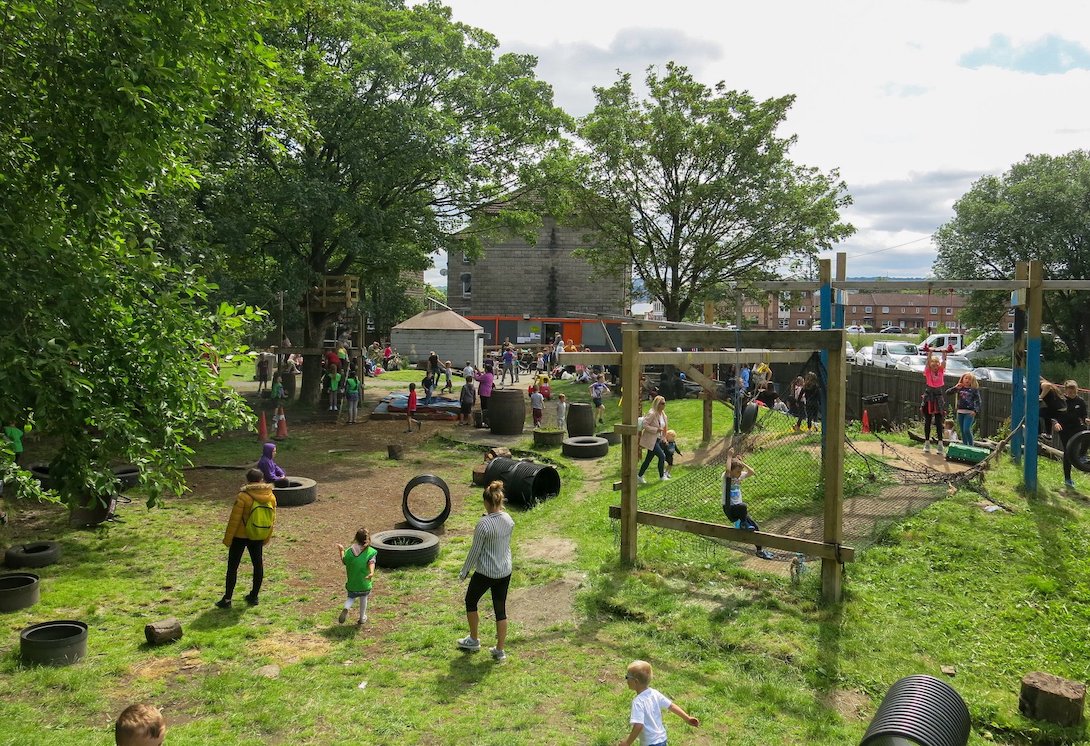Design of our public spaces should embrace children and their development by enabling diverse play wherever possible

Words by Amica Dall and Penny Wilson
Walking around my east London neighbourhood during lockdowns, I wondered what the children were doing. Most of the homes near me have no gardens; most don’t even have the insult-to-injury Juliet balconies that can accommodate – at the very least – a wistful stare or a breath of fresh air.
I was hearing stories from families living in tiny homes about neighbours banging on walls or floors, shouting and complaining about the intrusion of the most everyday noises made by children imprisoned for 23 hours a day. We all experienced privations during lockdowns, but for children the loss of free play with their peers could possibly carry a real and lasting impact.
Play deprivation is an unfilled negative at the core of children’s (and subsequently adults’) lives. It’s not just a positive thing that is missed – some fun not had. In play we find out about ourselves, other people, our world, our minds, bodies and emotions.
The need to play is hardwired into children. It is the evolved mechanism for learning, utterly different from and undervalued in contrast to the process-driven experience of being taught by rote or example, which seems so highly prized.
The emptiness of those lockdown streets exposed starkly just how hostile the city is to children. The ‘play areas’ included in most developments barely meet the minimum standard that planning officers will accept. Designed as afterthoughts, they are usually next to the rubbish bins or squeezed between lucrative parking places.
The surrounding fences signify clearly that ‘everywhere else but within this space, play is not welcome’. Those fences were now padlocked. Playgrounds were swathed in hazard tape and warning notices, flagging up danger of death. Some had explicit warnings about licking the equipment.

Play isn’t optional – it’s not just ‘nice to have’, not a luxury like a football cage or tennis court. Childhood days shouldn’t be shrivelled by small, design-poor space. Children don’t know, yet, that ‘play areas’ are a stingy concession made to their very existence, and yet they are still better than the nothing afforded to them in the rest of the public domain. They become acclimatised to this being the norm before they have either the experience or the language to complain about it.
It’s not just the paucity of positive provision, but the lack of both explicit and tacit permissions from the adult world which is so excruciating and damaging. Most grown-ups have no idea how extremely serious the situation for children has become – gradual change has crept up on us all like lobsters in boiling water.
It all comes down to something simple: wherever children and childhood are valued, play is accommodated and joyfully encouraged. So do our cities value children? Most playgrounds are lazy, ill-informed affairs. A fence surrounds a sea of rubberised safety surfacing with a few tangles of marooned catalogue-bought stuff. The design satisfies an adult idea of what children want.
Play is a complex, dynamic set of behaviours which evolve through a child’s life, responding both to their outer world and inner neurological reality. Sixteen different types of play have been observed wherever in the world children may play as they choose. Only one of these focuses purely on physical, gymnastic or locomotor play – the only kind which most playgrounds accommodate.
So what about the rest? The glorious complex phenomena which can be sad, challenging, exuberant, contemplative, rough, tender, solitary or collective. Try remembering the nuances, subtleties, the intellectual and emotional wealth of our own play. Can you imagine it happening in those landscapes in which the great business of childhood is now conducted?

Most people happily structure their private lives around the needs of their children. Why is it so hard to incorporate it into our public daily lives? We could easily design city landscapes which don’t position children as passive vulnerable creatures to be tolerated, and choose instead to embrace them.
It is wonderful to have quixotic dreams of car-free playable streets. But a child’s playhood is now, and it can’t be deferred until a grand design is completed. Tiny things can make huge differences to the spaces around you which children could easily be using daily. Even keeping areas free of glass, litter and dog poo helps makes them playable.
Assemble Play works in spaces that aren’t specifically designed for play, but are perfectly fit for purpose. Playworkers bring loads of loose parts (odd bits of stuff that can be anything children need in their playing) and support children to get on with what they want to do. We watch, with their adults, while they transform and create the worlds around them.
Public space is at a premium, and we need to share it. For a few hours we unleash the spectacle of play and then tidy it all away so the next thing can happen. Give a twist or two to the kaleidoscope and see play possibilities differently. With playworker support, plus cardboard boxes, bubbles, chalk, tarpaulins, rope or fabric, children will transform your local grotty playgrounds, parks or open spaces.
Don’t spend thousands on snazzy interventions, but regularly let corners and little spaces around you come to life in informal ways that build friendships and love of place. Look into having regular play streets. Find any way you can to make play part of the warp and weft of the lives of the children around you.
Amica Dall is a co-founder of Assemble and Baltic Street Adventure Playground. Penny Wilson is a playworker and part of Assemble Play, the new arm of Assemble
This article was featured in ICON’s Autumn 2021 issue. Read the digital edition for free


















